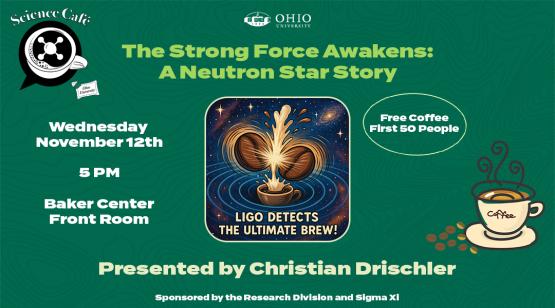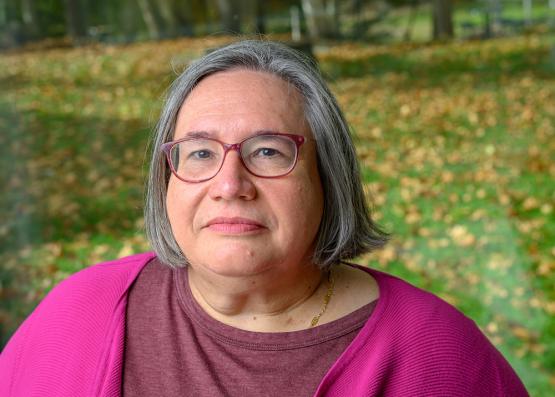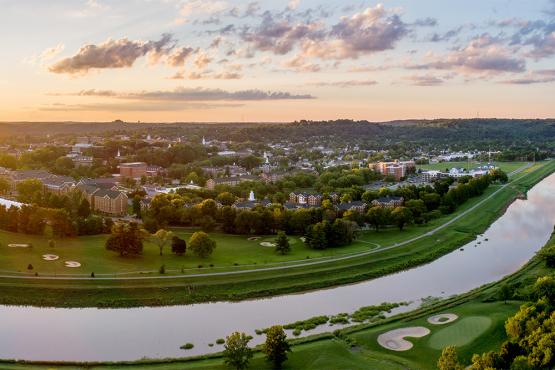
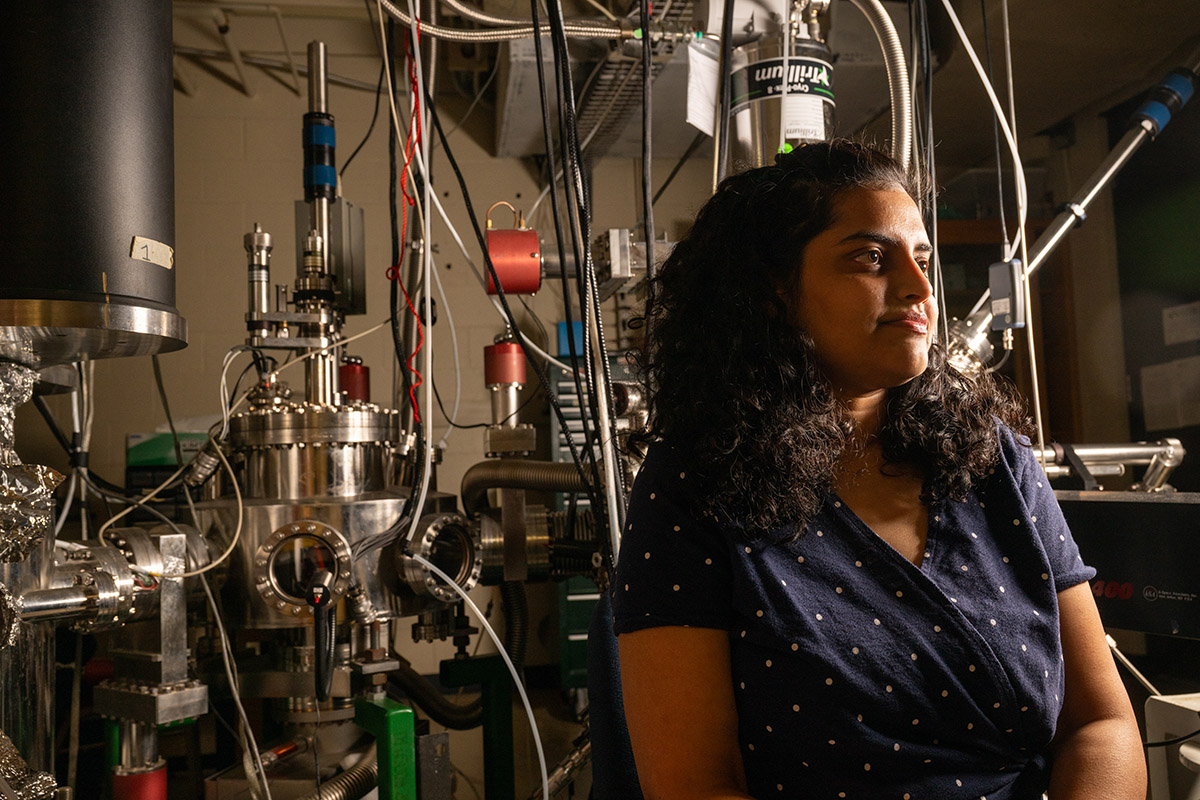
Unraveling big mysteries with tiny particles: PhD student takes award-winning approach to quantum research
Imagine being a detective, but instead of solving mysteries on the bustling streets of a metropolis, you're unraveling the secrets of the universe in a laboratory, one atom at a time. Sneha Upadhyay, an award-winning Ph.D. student at Ohio University in physics and astronomy, pulls out her quantum magnifying glass—or in this case, microscope—every day.
February 28, 2024
Share:
In a lab named to impress even a non-physicist (the Low Temperature/Variable Temperature-Spin Polarized Scanning Tunneling Microscopy-Molecular Beam Epitaxy lab, or the LT/VT-SPSTM MBE lab), Sneha works on experiments that feel like unsolved mysteries to most people. Under the guidance of advisor Physics and Astronomy Professor Arthur R. Smith, she's part of a team in the College of Arts & Sciences exploring new frontiers in quantum materials, a use for quantum physics that may reveal the future of healthcare, sustainable energy, space exploration, among others.
Using tools and techniques that allow her to manipulate materials at the atomic level, Sneha can adjust the types of atoms used, their order of assembly, and environmental conditions needed for the formation of quantum materials that can be used to create faster and more efficient electronic devices, quantum computers, sensors, and other technologies used in these fields. Spintronics, as her area of research is known, is focused on how an electron’s spin, rather than its charge, can inform new types of electronics.
Sneha’s standout accomplishments in the lab go beyond understanding how certain materials can switch their properties in ways that could revolutionize how we store data or power devices. Her time at OHIO has also allowed her to become an expert in the lab’s equipment, from re-engineering an ultra-low temperature microscope used to look at atoms to updating the parts of the lab's molecular beam epitaxy (MBE) machine with her lab mate, Tyler Erickson.
What's even more impressive? In November 2023, Sneha stood out among scientists from all over the country to win a National Graduate Research Award at the AVS International Symposium, awarded to only eight students nationally each year. This national acclaim is a testament to her hard work and the exciting potential of her research.
Sneha answered a few questions for OHIO News about the award, her work in the lab, and how women in science can stack the deck for success.
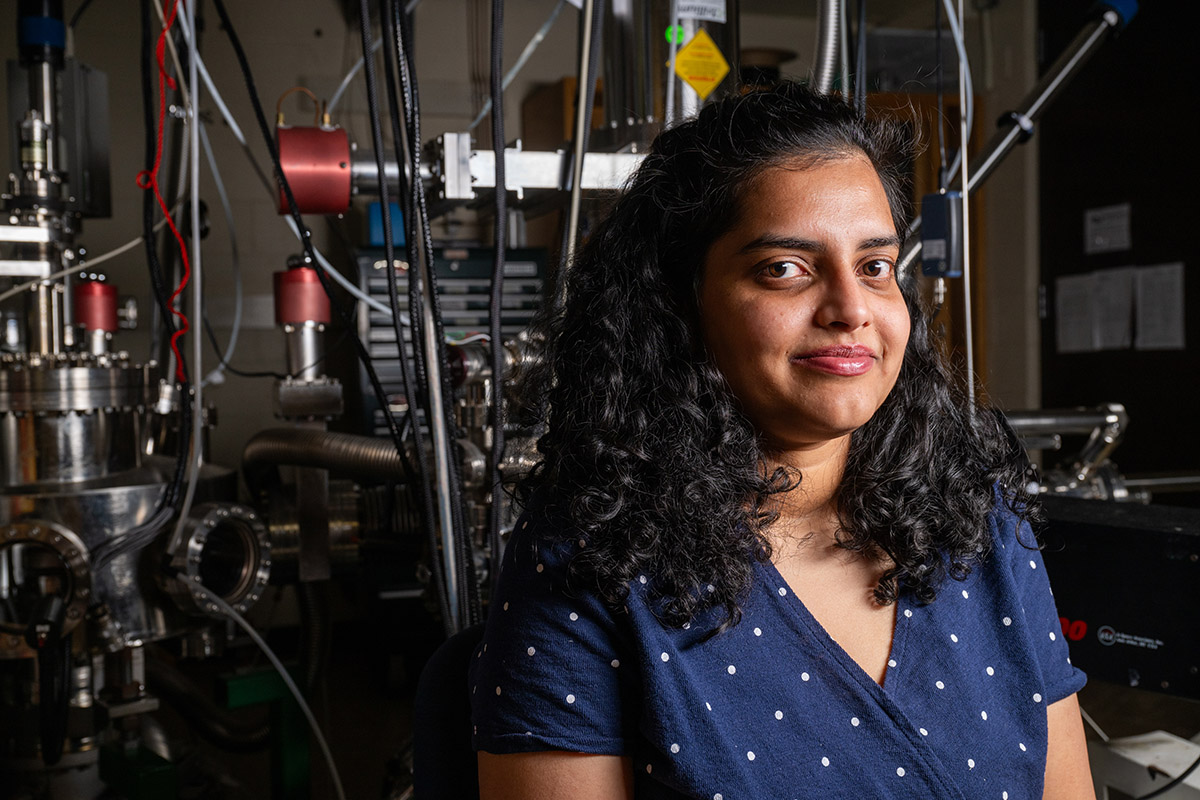
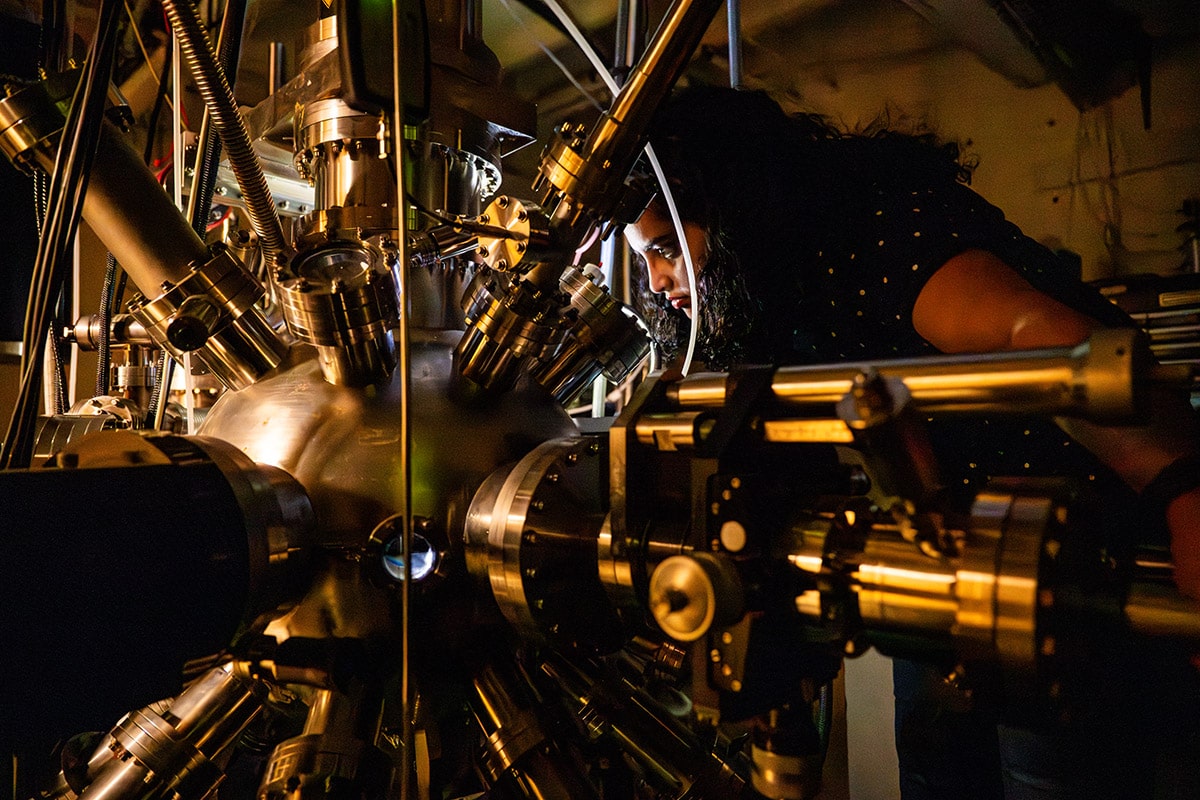
Photos by Ben Seigel.
Q & A with Sneha Upadhyay
Q: Congratulations on winning the prestigious National AVS Student Research Award! Could you give us a brief overview of your research in quantum materials and why it's significant in physics and astronomy?
A: Today we are looking to quantum materials as potential future for the field of spintronics. My work mainly pertains to understanding the growth, surface and interface dynamics of Mn3Sn [Kagome-structured manganese-tin alloy] on the chosen substrate. My study aimed to learn how to grow this material effectively, as well as understand the science behind the grown film. For example, “What is the reason that this material’s particular orientation is growing on this substrate?” or “Why is there a strain in this material?” I think understanding of these intricate details is important to the field.
Q: Only eight students nationwide receive this award each year. What does winning this award mean to you personally and professionally?
A: Firstly, it feels great and slightly overwhelming and I have extreme gratitude. I have received many awards during my Ph.D journey but this was special for multiple reasons. I had been to the conference twice and I knew that the stage was larger as well as it’s the research community that I have been reading about or heard about. So when I got to know that I was one of the top eight, that news came as a shock to me, but later it sunk in. I remember the day I received the award and met fellow awardees, I felt so appreciated not just for the work but also as a fellow researcher.
Q: What should people outside of the field of physics know about your research?
A: Today everyone uses data storage devices, and the research field is in continuous search of new materials [to build these devices]. So the work we are doing at Professor Smith’s lab at OHIO is an effort to study the magnetic and surface properties of the materials to find out if they can be a good candidate in the future for technology. Technology develops because of continuous R&D work, which is a long process, but every small bit of contribution to the field helps.
Q: You've been working in your lab since 2017. What inspired you to pursue this specific area of study in physics and astronomy?
A: During my master’s [studies] in India, I was introduced to the experimental part of physics, which I loved. So I gained different experiences and then I came to Ohio University, where I decided to join Professor Smith’s lab. I remember the first day I came to visit the lab, I was speechless, as never before I worked on such a complicated machine, but that did not scare me—it actually felt like a challenge to myself. Additionally, the idea of studying different magnetic materials which could be used for technological purposes was something that attracted me. I have always been a person who wants to give back to the community, even if in the smallest way possible. Before joining the lab, I had no experience in this field, which provided me a chance to learn something new and improve myself. Today when people tell me that I am good at something in the lab, it is due to the experience I got at Professor Smith’s lab.
Q: Can you share a particularly challenging moment in your lab and how it shaped you, not just as a scientist but as a person?
A: The lab [at OHIO] always presented new challenges every day. There were many moments in the lab where my patience and promptness to react to a situation was tested. I cannot think of any particular moment, as there are plenty and picking one is hard. But all the challenges I faced in the lab shaped me as a person and as scientist. These challenges taught me that if I am faced with a situation I should first step back and assess the situation before I jump on it, which is so important, for especially people like me who work with machines. My progress in lab is due to the constant support of my lab mates Tyler Erickson, Ashok Shrestha, Ali Abbas, Hannah Hall, and Cherie D’Mello. Additionally, I became a more aware, patient, and confident person. I learned how to make decisions on the go and trust my decisions. Now when I leave OHIO for a postdoc position, I won’t feel overwhelmed or scared as I think I am personally and professionally ready for a change.
Q: What advice would you give to early students, especially women, who are interested in pursuing a career in physics and astronomy?
A: Firstly, anyone can have a career in physics and astronomy, invariable of their gender. Physics and astronomy have different sub-fields, and one can choose what they like and enjoy. If you’re an early career student and decide to do physics, I would recommend exploring some internships in different sub-fields to see what you like the most. Additionally, don’t be afraid of challenges! These challenges might look like a mountain initially, but with experience those same challenges would look very easy. For women especially, don’t judge a group by seeing what its representation is like. I always believe and want other women to know, if you are good and have the knowledge, speak up the loudest and people will hear you. Women can also join the Women in Physics group and connect with other women to make a safe community. Especially for students who plan to do Ph.D, remember it’s a long road and trust in yourself and the process, there are going to be so many ups and downs, but you have to keep your head strong and sail.
Q: Are there any popular science myths or misconceptions that you encounter in your field? Can you debunk one for us?
A: I am not sure if this is a myth, but I was always told that women have certain limitations—like they cannot be in physics. When I joined the field of physics, I realized that not many women are there, but the women that were there are strong and knowledgeable and at good positions. That when I realized that it’s not about gender, it about your personality and your knowledge.
Q: How do you think your work in quantum materials can change or improve our everyday lives in the future?
A: I see quantum materials as a large ocean, and my work is a drop in it as it's an effort that needs to be made. I don’t know what future holds, but in the field, it’s believed that the Kagome materials are the next thing that can be a potential candidate for storage devices. And I would like to believe that everyone in the field is trying to add a drop in this ocean within their own potential.
Q: Who are your role models, and in what ways have they shaped your approach to life and work?
A: I never had any role models as such, but when I did find certain aspects of someone’s life interesting, I wanted to imbibe it. I know it sounds weird, but when I meet people I always learn something new. I have met people from different walks of life and they have taught me things that have changed my approach to life and work. Today, the things I have learned are part of my life and work: for example, the attitudes of giving back to the community, living in the present. I think one major thing I have learned, and it has shaped me immensely, is not seeking validation from others too much, which I think has made my life easier. I do like to be appreciated sometimes—but not every time. I don’t work for validation, I work because I enjoy it and I am learning as well as adding value to the collaborative effort, which is more important to me. This means that is am not only defined by my work, but other things in life are where I can derive my happiness too.
Q: When you step away from your experiments and data, what's your favorite way to unwind and recharge?
A: During my Ph.D. here at OU, I always took time for myself as I believe that if I am not happy and fresh my work is going to suffer. So my favorite way of unwinding is taking a nice shower, making some coffee and reading a murder mystery book in my cozy apartment. I also love doing embroidery, watching TV and I like catching up with friends too. I also make sure to recharge myself everyday by working out, going out for walks, listening to podcasts, and meditating.

